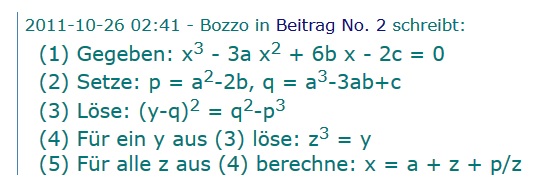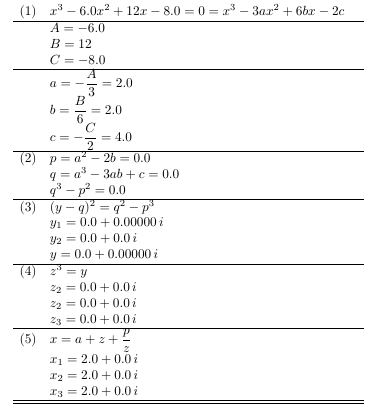|
Ich habe einmal aus Reiz etwas zusammengeschrieben. Ich habe mich dabei an diesem Verfahren orientiert: Für einfache Beispiele tut es: Für komplizierte Beispiele ist meist nur das erste Ergebnis richtig. Öffne in Overleaf
\documentclass[margin=5pt]{standalone} \usepackage{amsmath, amssymb} \usepackage{tikz} %\usepackage{fp} %\usetikzlibrary{fixedpointarithmetic} %\pgfkeys{/pgf/fixed point arithmetic} \begin{document} % Beispiel x³+Ax²+Bx+C=0 %% x^3 - 6 x^2 + 12 x - 8 = (x-2)^3 \pgfmathsetmacro{\A}{-6} % \pgfmathsetmacro{\B}{12} % \pgfmathsetmacro{\C}{-8} % %% x^3 - x^2 - x - 1 = 0 = schwieriges Ergeb. %\pgfmathsetmacro{\A}{-1} % %\pgfmathsetmacro{\B}{-1} % %\pgfmathsetmacro{\C}{-1} % %%% x^3-5x^2-4x+20 =(x-5)(x-2)(x+2) %\pgfmathsetmacro{\A}{-5} % %\pgfmathsetmacro{\B}{-4} % %\pgfmathsetmacro{\C}{20} % % %% x^3 - 6 x^2 + 11 x - 6 = (x-1)(x-2)(x-3) %\pgfmathsetmacro{\A}{-6} % %\pgfmathsetmacro{\B}{11} % %\pgfmathsetmacro{\C}{-6} % % %%% c^3−13c^2−21c+377= 0 geht nicht %%\pgfmathsetmacro{\A}{-13} % %%\pgfmathsetmacro{\B}{-21} % %%\pgfmathsetmacro{\C}{377} % % %% x^3-6.5 x^2-5.25 x+47.125 = 0 %\pgfmathsetmacro{\A}{-6.5} % %\pgfmathsetmacro{\B}{-5.25} % %\pgfmathsetmacro{\C}{47.125} % % Berechnung \pgfmathsetmacro{\Avz}{\A<0 ? "\A" : "+\A"} \pgfmathsetmacro{\Bvz}{\B<0 ? "\B" : "+\B"} \pgfmathsetmacro{\Cvz}{\C<0 ? "\C" : "+\C"} \pgfmathsetmacro{\a}{-\A/3} % \pgfmathsetmacro{\b}{\B/6} % \pgfmathsetmacro{\c}{-\C/2} % \pgfmathsetmacro{\p}{\a^2-2*\b} % \pgfmathsetmacro{\q}{\a^3-3*\a*\b+\c} % \pgfmathsetmacro{\D}{\q^2-\p^3} % \pgfmathsetmacro{\DTest}{\D > 0 ? 1 : 0} % \ifnum\DTest=1 \pgfmathsetmacro{\yIre}{\q+sqrt(\q^2-\p^3)} % \pgfmathsetmacro{\yIim}{0} % \pgfmathsetmacro{\yIimVZ}{\yIim<0 ? "" : "+"} \pgfmathsetmacro{\yIIre}{\q-sqrt(\q^2-\p^3)} % \pgfmathsetmacro{\yIIim}{0} % \pgfmathsetmacro{\yIIimVZ}{\yIIim<0 ? "" : "+"} \pgfmathsetmacro{\y}{"\yIre"} %\pgfmathsetmacro{\y}{\yI >= 0 ? \yI : \yII} % \else% \pgfmathsetmacro{\yIre}{\q} % \pgfmathsetmacro{\yIim}{sqrt(-\q^2+\p^3)} % \pgfmathsetmacro{\yIimVZ}{\yIim<0 ? "" : "+"} \pgfmathsetmacro{\yIIre}{\q} % \pgfmathsetmacro{\yIIim}{-sqrt(-\q^2+\p^3)} % - \pgfmathsetmacro{\yIIimVZ}{\yIIim<0 ? "" : "+"} \pgfmathsetmacro{\y}{"\yIre \yIimVZ \yIim \,i"} \fi% \pgfmathsetmacro{\yAbs}{sqrt((\yIre)^2+(\yIim)^2)} % \pgfmathsetmacro{\yW}{\yAbs^(1/3)} % \pgfmathsetmacro{\yArg}{atan2(\yIim,\yIre)} % \pgfmathsetmacro{\zIre}{\yW*cos(\yArg/3)} \pgfmathsetmacro{\zIim}{\yW*sin(\yArg/3)} \pgfmathsetmacro{\zIimVZ}{\zIim<0 ? "" : "+"} \pgfmathsetmacro{\zIabs}{sqrt((\zIre)^2+(\zIim)^2)} \pgfmathsetmacro{\zIIre}{\yW*(-cos(\yArg/3)-sqrt(3)*sin(\yArg))/2} \pgfmathsetmacro{\zIIim}{\yW*(sqrt(3)*cos(\yArg/3)-sin(\yArg))/2} \pgfmathsetmacro{\zIIimVZ}{\zIIim<0 ? "" : "+"} \pgfmathsetmacro{\zIIabs}{sqrt((\zIIre)^2+(\zIIim)^2)} \pgfmathsetmacro{\zIIIre}{\yW*(-cos(\yArg/3)+sqrt(3)*sin(\yArg))/2} \pgfmathsetmacro{\zIIIim}{\yW*(-sqrt(3)*cos(\yArg/3)-sin(\yArg))/2} \pgfmathsetmacro{\zIIIimVZ}{\zIIIim<0 ? "" : "+"} \pgfmathsetmacro{\zIIIabs}{sqrt((\zIIIre)^2+(\zIIIim)^2)} \pgfmathsetmacro{\pTest}{\p==0 ? 1 : 0} \ifnum\pTest=1% \pgfmathsetmacro{\xIre}{\a + \zIre}% \pgfmathsetmacro{\xIim}{\zIim}% \pgfmathsetmacro{\xIimVZ}{\xIim<0 ? "" : "+"}% % \pgfmathsetmacro{\xIIre}{\a+\zIIre}% \pgfmathsetmacro{\xIIim}{\zIIim}% \pgfmathsetmacro{\xIIimVZ}{\xIIim<0 ? "" : "+"}% % \pgfmathsetmacro{\xIIIre}{\a+\zIIIre}% \pgfmathsetmacro{\xIIIim}{\zIIIim}% \pgfmathsetmacro{\xIIIimVZ}{\xIIIim<0 ? "" : "+"}% \else% \pgfmathsetmacro{\xIre}{\a+\zIre*(1+\p/\zIabs^2)}% \pgfmathsetmacro{\xIim}{\zIim*(1-\p/\zIabs^2)}% \pgfmathsetmacro{\xIimVZ}{\xIim<0 ? "" : "+"}% % \pgfmathsetmacro{\xIIre}{\a+\zIIre*(1+\p/\zIIabs^2)}% \pgfmathsetmacro{\xIIim}{\zIIim*(1-\p/\zIIabs^2)}% \pgfmathsetmacro{\xIIimVZ}{\xIIim<0 ? "" : "+"}% % \pgfmathsetmacro{\xIIIre}{\a+\zIIIre*(1+\p/\zIIIabs^2)}% \pgfmathsetmacro{\xIIIim}{\zIIIim*(1-\p/\zIIIabs^2)}% \pgfmathsetmacro{\xIIIimVZ}{\xIIIim<0 ? "" : "+"}% \fi% $\begin{array}{c l r} (1) & x^3 \Avz x^2 \Bvz x \Cvz = 0 = x^3 -3a x^2 + 6b x - 2c \\ \hline & A = \A & \\ & B = \B & \\ & C = \C & \\ \hline & a = -\dfrac{A}{3} = \a \\ & b = \dfrac{B}{6} = \b \\ & c = -\dfrac{C}{2} = \c \\ \hline (2) & p = a^2-2b = \p \\ & q = a^3-3 ab+c = \q \\ & q^3-p^2 = \D \\ \hline (3) & (y-q)^2 = q^2-p^3 \\ & y_1 = \yIre \yIimVZ \yIim \,i \\ & y_2 = \yIIre \yIIimVZ \yIIim \,i \\ & y=\y \\ \hline (4) & z^3 = y \\ & z_2 = \zIre \zIimVZ \zIim \,i \\ & z_2 = \zIIre \zIIimVZ \zIIim \,i \\ & z_3 = \zIIIre \zIIIimVZ \zIIIim \,i \\ \hline (5) & x = a + z + \dfrac{p}{z} \\ & x_1 = \xIre \xIimVZ \xIim \,i \\ & x_2 = \xIIre \xIIimVZ \xIIim \,i \\ & x_3 = \xIIIre \xIIIimVZ \xIIIim \,i \\ \hline\hline \end{array}$ \end{document}
Ergebnis 5 von 8
show 3 more comments
|
Folgen dieser Frage
Per E-Mail:Wenn sie sich anmelden, kommen Sie für alle Updates hier in Frage
Per RSS:Markdown-Grundlagen
- *kursiv* oder _kursiv_
- **Fett** oder __Fett__
- Link:[Text](http://url.com/ "Titel")
- Bild?
- nummerierte Liste: 1. Foo 2. Bar
- zum Hinzufügen ein Zeilenumbruchs fügen Sie einfach zwei Leerzeichen an die Stelle an der die neue Linie sein soll.
- grundlegende HTML-Tags werden ebenfalls unterstützt
Frage-Themen:
gestellte Frage: 17 Apr '19, 20:30
Frage wurde gesehen: 2,561 Mal
zuletzt geändert: 22 Apr '19, 05:16



Erstens ist das keine Frage und zweitens weiß ich nicht, wie oft man dir noch sagen muss, dass man die Einbuchstabenmakros nicht überschreiben soll. Daher -1
Bei dem Umfang war das mein kleinstes Problem und da habe ich gedacht, da nehme ich mal den Stock aus dem Arsch. Kannst Du ja auch mal versuchen. Du würdest überrascht sein.
Ich habe Deinen Code nicht ausprobiert (auch weil ich nicht der Meinung bin, dass TikZ ein Computer Algebra System ist), aber vermute ganz stark, dass es daran liegt, dass TikZ Potenzen etwas "unkonventionell" parst. Probier doch mal, alle
\q^2etc. durch(\q)^2bzw.pow(\q,2)etc. zu ersetzen.(\q)^2musste ich eh, weil er sonst negative Wurzeln findet oder sowas.powwäre noch so eine Idee.Das war jetzt halt mehr der Reiz, das mal zu testen. Mit SageTeX wäre das eine Zeile.
Ich sehe halt trotzdem viele Zeilen der Art
\pgfmathsetmacro{\yIim}{sqrt(-\q^2+\p^3)}. Probier doch mal, ob es besser wird, wenn Du alle ^ ersetzt, z.B. hier\pgfmathsetmacro{\yIim}{sqrt(-pow(\q,2)+\p^3)}(ungerade Potenzen sind wurscht).Kleine Rückmeldung: Hat leider nicht geholfen.
Bei wikipedia stehen geschlossene Formeln...
@user0 Ja, ich weiß. Interessant ist da z.B. auch die PQRST-Formel. Da war mein Problem, dass schnell die "Dimensions too large" werden.